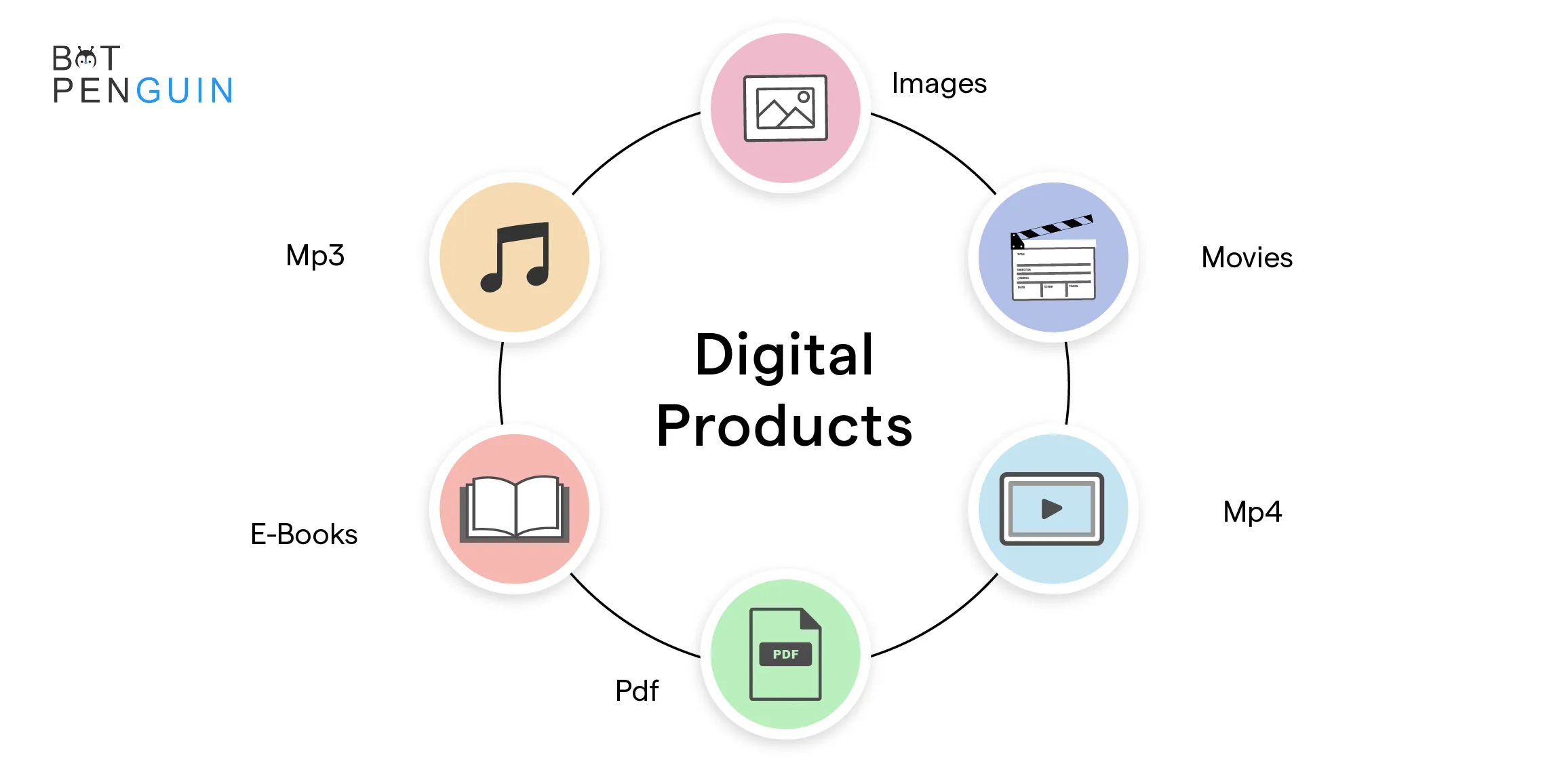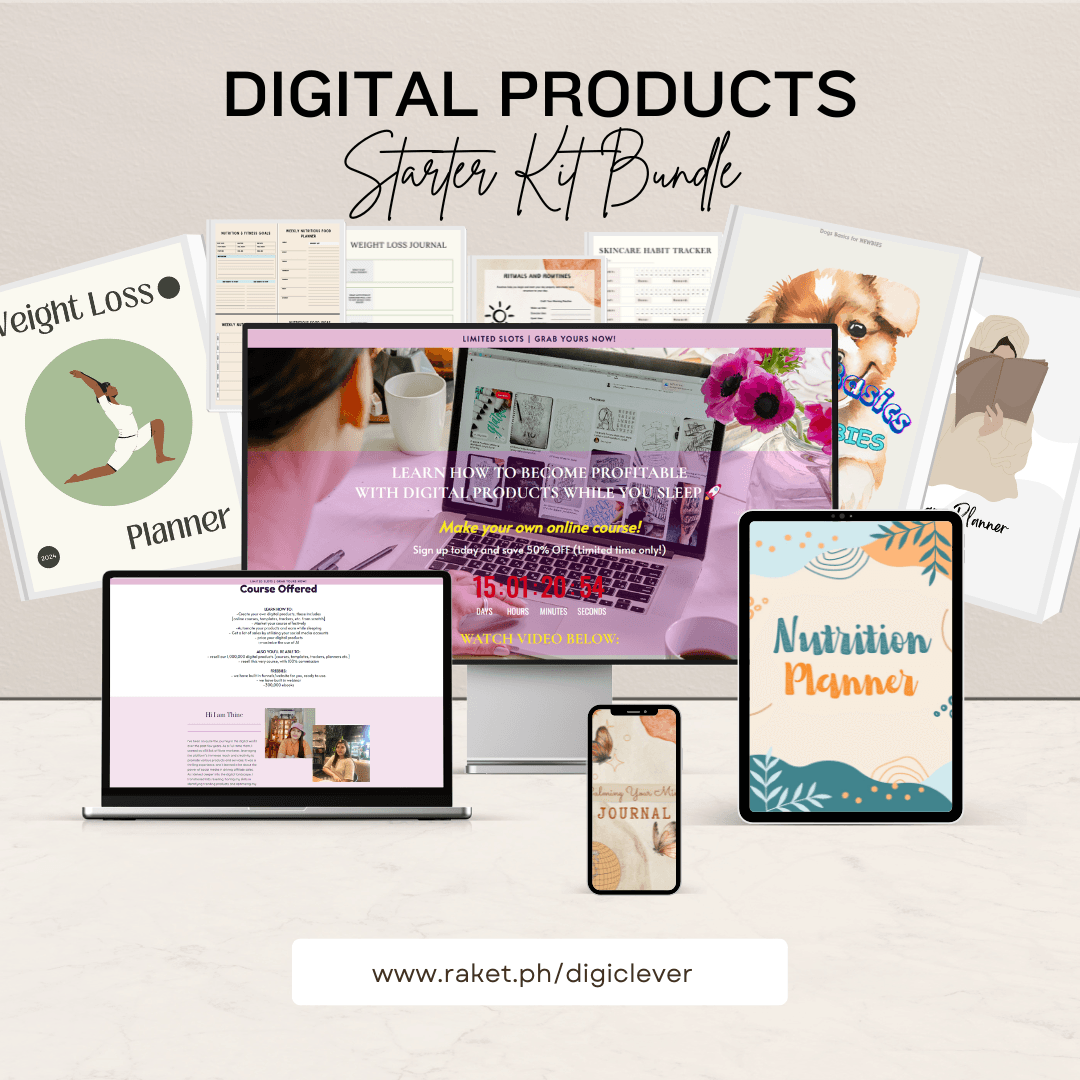
What Are Digital Products?
Digital products are intangible assets that exist in a digital format, which can be created, distributed, and consumed online. Unlike physical products, digital products are not bound to a specific location or material form; they can be accessed from anywhere in the world, provided that the consumer has an internet connection. This versatility makes digital products particularly valuable in today’s economy, as they cater to a wide range of consumer needs and preferences.
There are various types of digital products, each serving different market demands. One of the most popular forms is eBooks, which offer readers the convenience of accessing literature or educational content on their electronic devices. Another prominent example is online courses, which have gained significant traction in recent years, allowing individuals to acquire new skills or knowledge at their own pace through interactive platforms.
Software is another category of digital products that plays a crucial role in both personal and professional contexts. From applications for smartphones to complex enterprise software, these digital solutions enhance productivity and efficiency across various industries. Furthermore, digital artwork, including graphic designs and illustrations, represents another vital segment of this market, as artists sell their creative works in a digital format, transcending geographical barriers.
The importance of digital products cannot be overstated, as they contribute significantly to the economy by enabling entrepreneurs and creators to monetize their talents without the constraints associated with physical goods. The rise of digital platforms and technological advancements continues to shape the landscape, encouraging innovation and providing consumers with endless choices. As we explore the potential of digital products, it becomes increasingly evident that they hold a central role in the modern marketplace, with opportunities for growth and income generation on the rise.
The Rise of Digital Products in Today’s Market
The emergence of digital products marks a significant shift in the marketplace, driven by the convergence of consumer needs and technological advancements. In recent years, we have increasingly witnessed a transition from physical goods to digital solutions, reshaping both retail and service industries. This transformation is largely influenced by a growing demand for convenience, as consumers favor quick access to content, tools, and services that foster efficiency and immediacy.
Technological innovations have played a crucial role in this evolution, with widespread internet accessibility, the proliferation of smartphones, and the expansion of cloud computing. These advancements facilitate the creation and distribution of digital products, enabling businesses and creators to reach larger audiences with relative ease. For instance, e-books, online courses, and software applications have surged in popularity, meeting the demands of consumers who seek alternatives that do not require physical storage or transportation.
Moreover, changing consumer behavior is also a driving force behind the rise of digital offerings. Today’s consumers increasingly prioritize instant gratification; they desire products that can be accessed at any time and place without barriers. The preference for digital solutions can be observed in various sectors, including education, entertainment, and health. Users now gravitate towards streaming services, online training modules, and mobile health applications, highlighting a significant trend towards on-demand services and learning.
This shift has prompted traditional businesses to reconsider their product offerings, with many now incorporating digital components into their existing lines. As companies adapt, the potential for innovation in creating meaningful digital products continues to expand, catering to the evolving preferences of a digitally-savvy customer base. Thus, understanding the rise of digital products is crucial for anyone looking to engage in today’s dynamic market landscape.
Benefits of Digital Products for Creators
Creating digital products offers numerous advantages for content creators that can significantly enhance both their business model and overall profitability. One of the most compelling benefits is the lower overhead costs associated with their production and distribution. Unlike traditional physical products, digital goods such as eBooks, online courses, and software do not require physical materials, storage, or shipping. This reduction in operational expenses allows creators to reinvest their profits into further product development and marketing strategies.
Another significant advantage of digital products is their scalability. Once a digital product is created, it can be sold to an unlimited number of customers without incurring additional costs for each unit sold. This characteristic enables creators to reach a much larger audience without the constraints often found in physical inventory management. As a result, a single well-made digital product can continuously generate revenue over time, further improving financial returns.
Moreover, digital products provide an excellent opportunity for passive income. After the initial creation and marketing efforts, these products can often sell themselves over time through automated systems. Email marketing, social media promotion, and content marketing can all drive ongoing sales without requiring constant attention from the creator. This aspect of digital products allows individuals to focus on developing new offerings or engaging in other endeavors while still generating income.
Lastly, creators have the potential to reach a global market with their digital offerings. The internet removes geographical barriers, allowing individuals to sell their products to customers worldwide. This expansive reach means that if a product resonates with an audience, it can quickly gain popularity far beyond local or regional confines. In summary, the benefits of creating digital products are substantial, making it an appealing avenue for creators looking to succeed in today’s digital economy.
Common Types of Digital Products
Digital products have gained substantial traction in recent years, driven by the increasing demand for online content and resources. Understanding the common types of digital products can help individuals and businesses leverage these assets to generate income effectively. Here are five prevalent categories of digital products.
eBooks are one of the most popular digital products available. They provide readers with in-depth information or storytelling on various topics, from self-help to technical manuals. Authors can sell eBooks through their websites or platforms such as Amazon Kindle, allowing them to reach a broad audience without the constraints of traditional publishing.
Online courses represent another lucrative digital product type. With the rise of e-learning platforms, educators and experts can design courses to share their knowledge and skills across diverse subjects. Course creators often utilize multimedia elements, such as videos, quizzes, and interactive forums, to enhance the learning experience. This format caters to individuals looking to acquire new skills or knowledge at their convenience.
Stock photos serve as vital resources for marketers and content creators who require visually appealing images for their projects. Photographers can monetize their work by uploading high-quality images to stock photography websites, allowing businesses to purchase licenses for legal use. This type of digital product not only showcases artistic talent but also provides a passive income stream for photographers.
Software applications, including mobile apps and web-based tools, are essential digital products that fulfill specific needs or improve productivity. Software developers create applications that help users streamline tasks, manage projects, or enhance their entertainment experience. Monetization methods can include subscription models, in-app purchases, or one-time purchases.
Lastly, music files play a crucial role in the digital product landscape. Musicians and composers can share their work through online platforms, making it accessible to global audiences. Independent artists can produce and sell their music digitally, often taking full control of their distribution and pricing strategies.
In conclusion, digital products such as eBooks, online courses, stock photos, software applications, and music files provide numerous opportunities for generating income in the digital marketplace. Understanding these types can pave the way for effective monetization strategies.
Ways to Monetize Digital Products
Monetizing digital products has become an essential strategy for entrepreneurs and creators in the digital landscape. There are several effective methods to generate revenue through these offerings. Understanding each approach enables individuals to select the one that aligns best with their goals and target audience.
One of the most straightforward methods of monetization is through direct sales. Creators can market their digital products, such as eBooks, software, or online courses, directly to consumers via personal websites or e-commerce platforms. By promoting these products effectively, individuals can set their pricing strategies to maximize profit margins. The key to success in direct sales lies in establishing strong marketing techniques and building trust with potential customers.
Another viable option is the subscription model, where users pay a recurring fee to access a range of digital content or features. This approach is particularly successful for membership sites, online learning platforms, and software-as-a-service (SaaS) providers. By offering continuous value through regular updates or exclusive content, businesses can create a steady stream of income, making subscribers feel part of a community that encourages loyalty and engagement.
Freemium models provide an attractive pathway for potential customers to engage with digital products initially for free, often with the option to purchase premium features or content later. This model works well for mobile applications, online tools, or educational platforms, where the free offering serves as an introduction, showcasing the product’s value and prompting upgrades to enhance the experience.
Lastly, affiliate marketing stands out as a lucrative method for monetizing digital products. By partnering with companies to promote their offerings, individuals can earn a commission for each sale generated through their referral links. This approach requires a solid understanding of the target audience and effective content marketing strategies to drive traffic and conversions.
Incorporating these various monetization strategies enables creators and businesses to effectively leverage their digital products, maximizing revenue potential while fulfilling consumer needs.
Platforms to Create and Sell Digital Products
In the realm of digital products, various platforms are designed to assist creators in both developing and distributing their offerings. Each platform presents unique features, audience engagement opportunities, and revenue structures ideal for specific types of digital goods. Understanding these options can greatly influence the success of a digital product.
Amazon Kindle is one of the most prominent marketplaces for eBooks. It provides authors with a straightforward way to publish and sell their written work. With the Kindle Direct Publishing (KDP) program, writers maintain creative control, set their pricing, and earn royalties that vary based on sales. The widespread reach of Amazon’s customer base further amplifies visibility, making it an attractive option for digital authors.
For those interested in creating educational content, Udemy serves as a robust platform for online courses. With its user-friendly interface, course creators can develop comprehensive educational experiences that incorporate videos, quizzes, and interactive materials. Instructors are encouraged to market their courses, benefiting from Udemy’s established audience while having the potential for substantial earnings.
Etsy, traditionally famed for handcrafted goods, has also emerged as a key player in selling digital art and graphics. Sellers can showcase various digital products such as printable planners, design templates, and artwork, appealing to a specific market that values creativity and originality. Etsy’s focus on unique, artistic offerings creates an ecosystem that nurtures digital creativity, making it an ideal venue for those selling artistic digital goods.
When selecting a platform, creators should consider factors such as target audience, desired interaction level, and commission fees. Each option presents unique advantages and challenges, influencing how digital products are marketed and sold. By aligning the platform with the product type and creator goals, individuals can better position their digital offerings for success in a competitive online landscape.
Marketing Digital Products Effectively
The successful marketing of digital products is crucial for maximizing sales and reaching a target audience effectively. Implementing the right strategies can significantly enhance a brand’s visibility and improve overall profitability. One effective approach is leveraging email marketing. Building a targeted email list allows creators to directly communicate with interested customers about new releases, updates, and promotions. It is essential to provide valuable content in these communications to maintain engagement and encourage conversions.
Another powerful strategy is social media advertising. Platforms such as Facebook, Instagram, and LinkedIn offer tailored advertising options that can connect digital product creators with potential buyers. Sponsored posts can help showcase the unique features and benefits of a product, while also enabling targeted outreach to specific demographics. It is vital to engage with followers consistently, responding to comments and messages, which helps build a community around the product and fosters loyalty.
Content marketing also plays a significant role in promoting digital products. Creating high-quality, informative content can attract organic traffic and position the brand as an authority in its niche. This could involve writing blog posts, creating videos, or developing podcasts that align with the interests of the target audience. Additionally, integrating search engine optimization (SEO) tactics into the content helps improve visibility in search engine results, making it easier for potential customers to discover the digital product.
Lastly, optimizing the product’s landing page is crucial for conversion rates. A well-designed landing page, with clear calls-to-action, showcases the value of the digital product effectively. By combining these strategies—email marketing, social media advertising, content marketing, and SEO—creators can enhance their ability to effectively reach their audience and boost sales of their digital products.
Challenges Faced by Digital Product Creators
The creation and sale of digital products can be a rewarding venture, yet it comes with its own set of challenges that creators must navigate. One significant concern is market saturation. As the digital marketplace has expanded rapidly, many niches are becoming overcrowded with similar offerings. New creators may find it difficult to differentiate their products in a saturated environment, necessitating a strong value proposition and unique selling point to attract potential buyers.
Intellectual property issues also pose a critical challenge for digital product creators. The ease with which digital products can be copied and distributed online has led to a rise in copyright infringements. Creators must be diligent in protecting their intellectual property rights by understanding the legal frameworks surrounding digital content. This includes leveraging licensing agreements and tracking usage of their products to prevent unauthorized distribution, which can diminish earnings and undermine creative efforts.
Another challenge that creators face is maintaining product relevance over time. The digital landscape evolves rapidly, with trends and technologies shifting frequently. This requires ongoing updates and enhancements to existing products to ensure they remain useful and appealing to users. Creators must invest time and resources into research and development to keep pace with user expectations and market demands. Failure to adapt can lead to obsolescence, further complicating the sustainability of a digital product-based business.
In summary, while the digital product landscape offers numerous opportunities, it is equally fraught with challenges that require careful consideration and strategic planning. Being aware of market saturation, intellectual property protections, and the importance of product updates can provide creators with a clearer pathway to success in an often competitive environment.
Case Studies of Successful Digital Product Launches
To better understand the potential of digital products, examining real-life examples serves as an important resource for aspiring creators. One such case study is that of an online course created by a digital marketing expert. By leveraging platforms such as Udemy, the expert developed a comprehensive program on digital marketing strategies that attracted thousands of students. The success of this digital product can be attributed to the expert’s deep knowledge of the subject matter, a well-structured curriculum, and effective promotion through social media campaigns. Their case illustrates how thorough understanding and targeted marketing can generate significant revenue from a digital course.
Another notable example is a set of design templates sold by a graphic designer on Etsy. The key to their success lay in the identification of a niche market that required customizable templates for small businesses. By conducting market research and understanding the pain points of their target customers, the designer was able to create a digital product that provided solutions while standing out in a crowded marketplace. This case emphasizes the importance of catering to specific audience needs and constantly iterating based on customer feedback to enhance product value.
Finally, consider the success of an e-book authored by a wellness coach. The e-book addressed prevalent issues surrounding mental health and self-care, providing practical exercises and personal anecdotes. The launch strategy included a robust social media presence and partnerships with influencers in the wellness community. By creating buzz prior to the launch and maintaining engagement with readers, the coach secured strong initial sales and a loyal following. This example highlights the importance of community engagement and the utilization of social networks in promoting digital products effectively.
Each of these case studies reveals that successful digital product launches are often rooted in thorough research, understanding audience needs, and effective marketing strategies. By applying the lessons learned from these examples, aspiring creators can navigate their own journeys in the realm of digital products.






